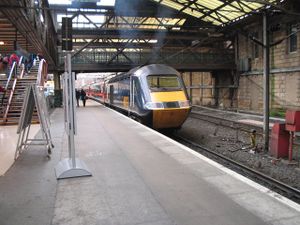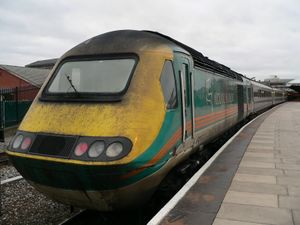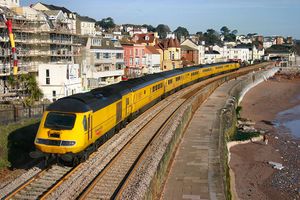British Rail Class 43 (HST)
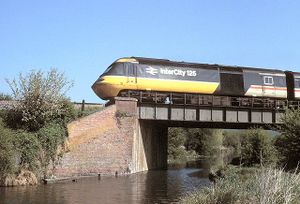
The British Rail Class 43 is the classification used for the InterCity 125 High Speed Train power cars, built by BREL from 1976 to 1982
The class are officially the fastest diesels in the world, with an absolute maximum of 148 mph, and 125 mph regular service speed (200 km/h)
However, this diesel rail speed record has been unofficially broken twice by Russian (168 mph, 1992) and Spanish (159 mph, 2002) trains.
InterCity 125 is a brand name used to describe two Class 43 power cars with a rake of Mark 3 carriages between them to form a complete train.
Contents
Development
In the early 1970s the British Railways Board (BRB) were in the unenviable position that within only ten years or so the majority of their main-line diesel traction would need replacement. Financial limitations were tight and mass electrification was not possible, so a new generation of high-speed diesel train had to be developed.
The BRB wanted a cheaper and more reliable alternative to the Advanced Passenger Train, and the "prototype" high-speed train set was the result. The power cars, or locos as they were initially known, were designated Class 41 (later Class 252).
The prototype set was developed at the Railway Technical Centre, Derby, the power cars having being constructed by BREL Crewe Works and the Mk3 passenger cars by BREL at Derby Litchurch Lane Works. The engine used in the prototype power cars was the Paxman 'Valenta' 12RP200L, which developed 2,250 hp, with electrical equipment supplied by Brush. The power cars had a main driver's position at one end, which was aerodynamically shaped, and the other, flat end, having an auxiliary driving position for shunting purposes.
The two prototype power cars emerged from the works in June and August 1972 and were initially numbered 41001 and 41002, but after a short period the entire 'set', including the passenger coaches, became British Rail Class 252. The power cars were given the coaching stock numbers 43000 and 43001. After operating its initial proving trials on the Eastern Region the prototype High Speed Diesel Train (HSDT) was transferred to the Western Region where it was deployed on Paddington Bristol/Weston-super-Mare services
After seeing the advantages of this design, production orders were placed for similar trains for operation on the Western, Eastern, Scottish and London Midland Regions. Following the introduction of production HST sets the prototype unit was withdrawn, the power cars passing to the Research Division at Derby for use powering various high speed development trains.
BR deployment
When originally built at Crewe Works, the InterCity 125 units were considered to be diesel multiple units, and were allocated Classes 253 and 254 for Western and Eastern Region services respectively.
However, following problems with the power cars and the operational ease of removing power cars to perform scheduled maintenance, unit formations were abandoned and from then on HSTs were considered to be formed of two locomotives with a rake of semi-permanently-coupled Mark 3 carriages in between.
The 197 power cars produced are numbered 43002-43198. 43001 was applied to the second of the two prototype power cars, while the first of the pair, now preserved, became 43000, an unusual number as no other loco carried a triple-0 number (this was because it was not, at the time, classified as a locomotive).
Until the HST's introduction, the maximum speed of British trains was limited to 100 mph (160 km/h). The increased speed and rapid acceleration and deceleration of the HST made it ideal for passenger use, and slashed journey times around the country. The prototype InterCity 125 (power cars 43000 and 43001) set the world record for diesel traction at 143 mph (230 km/h) on June 12, 1973. An HST also holds the world speed record for a diesel train carrying passengers. On September 27, 1985, a special press run for the launch of a new Tees-Tyne Pullman service from Newcastle to London King's Cross, formed of a shortened 2+5 set, briefly touched 144 mph north of York. The current world diesel traction record of 148 mph (238 km/h) was set by an HST set on November 1, 1987, while descending Stoke Bank with a test run for a new type of bogie (which now runs under the Mk.4 coaches used on the same route). The record stands to this day.
BR Western Region
On Western Region, InterCity 125 trains designated Class 253 were introduced initially for all services from London to Bristol and South Wales, and then extended for most day-time services from London to Devon and Cornwall.
The Class 47 locomotives still operated the cross country services from Cornwall and South Wales to the Northeast via the West Coast Main Line, as well as London to the Midlands/Welsh Marches. However, Class 43s also replaced these services once the third batch of power cars was delivered. All of these HSTs consist of a 2+7 formation, normally with two first class carriages, a buffet and four second class carriages, all sandwiched between two power cars.
BR Eastern Region
On the East Coast Main Line, the InterCity 125 designated Class 254 was the staple stock from the retirement of the Deltic locomotives in 1980-82 to the introduction of the Intercity 225 following electrification in 1990.
During 1987, eight power cars were converted for use as Driving Vehicles with Class 91 locomotives during trials on the East Coast Main Line. The power cars were fitted with buffers and Time Division Multiplex equipment that allowed them to directly control a Class 91, and were moved over to the ECML where they were used on workings with Class 89 and then 91 locomotives from London to Leeds. After the Mk4 stock had been delivered, the power cars had the TDM equipment removed, and then reverted to their normal duties. The power cars used for this project can be easily identified as they are still fitted with buffers. They were transferred to Cross Country services for a while, but most are now in storage.
Class 43 formations are still used today on Hull, Edinburgh and north of Edinburgh services (i.e. where electrification has yet to reach). The basic East Coast formation is 2+8 (although this increased to 2+9 in 2002 when extra stock became available), normally with two first class carriages, one buffet (at the end of the first class section) and five (now six) standard class carriages, all sandwiched between the two power cars.
BR London Midland Region
On London Midland Region, InterCity 125 trains were introduced later than on the other regions. They initially appeared on the former Midland Railway route from London St. Pancras to Sheffield and Nottingham. Although they could not exceed 100 mph on any part of the route, they still delivered time savings compared with the loco-hauled trains they replaced.
The Midland Main Line received a series of speed improvements over the next two decades, until it became possible for HSTs to run at up to 110 mph on some sections. An upgrade to the full 125 mph was proposed by British Rail in the early 1990s, but this did not happen because of privatisation. HSTs have also occasionally worked out of London Euston on West Coast Main Line services, particularly to Holyhead and the North Wales coast.
There was a major HSTs remain the backbone of expresses on the route now, although they are now supported by new Class 170 diesel multiple units on semi-fast services. They normally run in 2+8 formation), normally with two first class trailers, one buffet (at the end of the first class section) and five standard class trailers, all sandwiched between the two power cars.
In-life development
When first built, the HSTs consisted of Driving Motor Brake (DMB - Class 43), Trailer Firsts (TF), Trailer Seconds (TS), Trailer Restaurant Unclassified Kitchen (TRUK) and Trailer Restaurant Second Buffet (TRSB). Later power cars had no guard's equipment, due to the Trailer Guard Second (TGS) carriages being built. These later power cars were simply classified as Driving Motor (DM - Class 43), although they still had luggage van space, so perhaps DMLV would have been more appropriate.
By 1987 most of the DMBs had lost their guard's equipment and were reclassified DM (although they retained a window by the luggage door on each side). By 1989 they were all designated Class 43.
During the late 1990s a batch of 25 HST power cars were re-engined utilising 12VP185L traction engines. These new Paxman engines attempted to bring improved fuel consumption and reduced emissions to the HST. However they have proved to be less reliable in service than hoped. The 12VP185L has also been introduced fleet wide within the Australian XPT series.
Operating companies
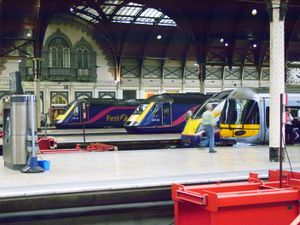
In 2004, 196 Class 43 locomotives were used by four train operating companies:
- First Great Western – the former Western Regional services from London to Bristol, Wales and the West Country.
- Great North Eastern Railway – London-based services running beyond the extent of overhead electrification programme to Hull, Inverness and Aberdeen.
- Virgin Trains – Cross Country services from Devon and Cornwall to the Northeast and Northwest via Birmingham New Street.
- Midland Mainline – HSTs have served long and well with MML and operate the faster routes to Sheffield, Leeds and York, alongside Class 222 'Meridians.'
Virgin quickly refurbished and supplemented their fleet as they replaced the Class 47s, and then shortened the formations to make them quicker. This released power units, which were put into store.
In conjunction with the WCML Upgrade, Midland Mainline were asked by the then-SRA to operate London-Manchester services via the Midland Mainline and the Hope Valley into London St. Pancras station station. In an operation dubbed "Project Rio", a large percentage of the stored Virgin Cross-Country power cars were overhauled and returned to service in an enlarged Midland Mainline fleet.
Hire company Cotswold Rail took two sets on lease in mid-2005, intended to be used for spot hire work with TOCs and also its charter operating arm Heartland Rail. This came to an end in August 2006 with the transfer of the lease to First Great Western as part of the massive expansion of its fleet.
Network Rail also operate a small HST power car fleet, used with its all-yellow New Measurement Train which can be seen regularly on main lines across the UK.
In 2006, Grand Central Railway purchased of six Class 43 Power Cars to operate its London-Sunderland passenger service on the East Coast Main Line. All of them have buffers (fitted so they could work with electric locomotives) and once worked on East Coast services before spending some time on Virgin Cross Country. The service was due to begin in December 2006. Upgrade work to enable the coaching stock, which was formerly used for locomotive-hauled services and has a different electric heating/power supply system, to operate with Class 43 power cars have pushed a likely start date back to mid 2007.
Disposal and storage
The first operator to dispense with its HST sets was Virgin Trains on both the CrossCountry and West Coast franchises in the period 2002-2004 following replacement by Voyager high speed DEMUs and the commencement of the CrossCountry Operation Princess timetable. The majority of the former Virgin Cross Country fleet went into storage but a small number moved to Midland Mainline to supplement its fleet, which was suffering reliability problems at the time.
Ending on 10 September 2004, the Project Rio fleet was gradually disbanded with power cars moving to First Great Western, GNER or into storage. Following withdrawal by Virgin in 2003, several power cars are now in store, at locations including Minehead at the western end of the West Somerset Railway. The stored sets occasionally went into 'service' on the West Somerset, but have all now moved to other locations. Midland Mainline now has considerable spare capacity in its HST fleet following the introduction of seven new 'Meridian' DEMUs after much negative publicity about the brand new trains standing idle because the service they were ordered for was axed by the Strategic Rail Authority. As the lease deal for the HSTs ends with the franchise in 2008, every power car remains on lease and with a reduced number of sets needed in service each day, the power cars are swapped in and out of formation to keep mileage and exams even throughout the fleet. Hire to other operators such as Virgin CrossCountry for its summer 'holidaymaker' trains has seen more usage for the fleet.
Life extension of HSTs
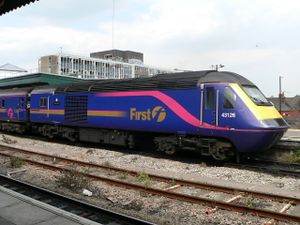
The Class 43, having been in operation since the late 1970s, is due for replacement by 'HST2'. The development cycle for the replacement series is such that the existing fleet may be required to operate through to 2015 or beyond. In support of this, a life extension programme is being considered. Such a programme will require ROSCOs and TOCs to address a number of issues within the power cars.
During the late 1990s 25 HST power cars were re-engined with Paxman 12VP185L engines in an attempt to reduce fuel consumption and emissions. However they have proved to be less reliable in service than hoped. The 12VP185L has also been introduced fleet-wide within the Australian XPT series.
During 2005, two Class 43 locomotives (43004 and 43009) operated by First Great Western were fitted with new MTU 16V 4000 engines and are currently being tested in passenger use on the Great Western Main Line. They can be identified by their modified headlight clusters, the quietness of the engine and the new 'Neon' livery. Also within First Great Western two power cars (43170 and 43179) have been fitted with updated 12VP185L engines. Both engine combinations offer improvements over the existing Paxman 12RP200 'Valenta' engines, with reduced smoke and exhaust emissions.
GNER has obligations following its re-franchise to replace engines within its Class 43 fleet, and is pursuing the MTU engine option following the trials conducted by First Great Western. First Great Western particularly compared the performance of the MTU-engined units with modified VP185 units.
After introducing Class 180 "Adelante" trains as a replacement on the Bristol and Cardiff routes and increasing service, First Great Western has decided in the light of customers' adverse comments (noise and vibration of the underfloor engines compared to the HST), to withdraw the Adelante from the Great Western mainline and replace them with additional refurbished Class 43s. In December 2005, First announced that all Great Western power cars will receive the MTU engine. The first batch was sent to Brush Traction for the installation of the new engines. The GNER fleet will also be fitted with MTU engines alongside the Great Western programme.
HST2
The youngest of the power cars is now 25 years old and thoughts are firmly set on the replacement for the High Speed Train. The project, known as HST2, is being spearheaded by the Department for Transport along with First Great Western and GNER. It is "back on track" following a period of uncertainty during the reign of the now abolished Strategic Rail Authority.
Scrapped
Of the total of 197 power cars four have been scrapped:
- 43001 - after prototype testing and approval, both it and its sister were transferred to departmental duties. 43000 is now preserved at York Railway museum, while 43001 was cut up by Booth Roe at Rotherham in December 1990.
- 43173 - written off in the Southall crash of 19 September 1997 and disposed of by Serco at MOD Shoeburyness once the enquiry had been completed.
- 43011 - written off in the Ladbroke Grove tragedy in 1999, being disposed of immediately after completion of the enquiry into the accident. Cut up by Sims Metals at Crewe Works in June 2002.
- 43019 - written off in 2004 after colliding with a car parked on a level crossing at Ufton Nervet between Reading and Newbury. Cut up by Sims Metals of Beeston in July 2005. (Power car 43139 is dedicated to the driver, Stanley Martin, 54, of Torquay, Devon who, sadly, perished in the tragedy.)
Factfile
| Specification | Details | ||
| Currently owned by: | Angel Trains or Porterbrook Leasing Company | ||
| Operated by: | First Great Western, GNER, Midland Mainline, Network Rail or Virgin Trains | ||
| Built: | 1976-1982 by BREL at Crewe Works. A total of 197units, including two prototypes | ||
| Engine: | Paxman Valenta 12RP200L of 1680 kW (2250 hp) at 1500 rpm (all except those shown below) | ||
| MTU 16V4000: 43004, 43009, 43092-094, 43097-098, 43175 | |||
| Paxman 12VP185: 43043-045, 43047-050, 43052, 43055, 43059-061, 43072-076, 43082, 43165, 43168-170, 43177, 43179, 43191 | |||
| Main alternator: | Brush BA1001B | ||
| Traction motors: | Brush TMH68-46 or GEC G417AZ | ||
| Maximum tractive effort: | 80 kN (17,980 lbf) until 64.5 mph | ||
| Continuous tractive effort: | 46 kN (10,340 lbf) | ||
| Power at rail: | 1320 kW | ||
| Wheel arrangement: | Bo-Bo | ||
| Train brakes: | Air brakes | ||
| Brake force: | 35 t (350 kN) | ||
| Dimensions: | 17.79 x 2.71 m | ||
| Mass: | 70.25 t | ||
| Wheel diameter: | 1020 mm | ||
| Design speed: | 125 mph | ||
| Maximum speed: | 125 mph | ||
| Fuel capacity: | 4500 litres | ||
| Route availability: | RA 5 | ||
| Electric train supply: | Three-phase electric | ||
| Multiple working: | Within class only. Jumpers on one end only except on 43013, 43014, 43065, 43067, 43068, 43080, 43084 and 43123, which have jumpers on both ends | ||
| Withdrawal/Scrapped | At present, three members of the class have been scrapped: 43011 Sims Metals at Crewe Works in June 2002; 43019 Sims Metals Beeston in July 2005 and 43173 Serco at MOD Shoeburyness in September 2003. All following severe accident damage | ||
In fiction
In The Railway Series of childrens' books originated by the Rev. W. Awdry, a High Speed Train visits the Island of Sodor. The two Class 43 power cars are introduced as Pip & Emma.
See also
- InterCity 125 - Two Class 43 power cars sandwiching a rake of Mark 3 coaching stock.
- Mark 3 coaching stock - Sandwiched between two Class 43 power cars to form an InterCity 125 set.
- High Speed Train - History of High Speed rail transport in the UK in general.
- InterCity - General InterCity brand before privatisation of British Rail.
- XPT - Australian high speed train whose design was derived from the Class 43
External links
| Wikimedia Commons has media related to: British Rail Class 43 |
| British Rail non-steam locomotives | ||
|---|---|---|
| Diesel locomotives - Electric locomotives - DMU - DEMU - AC EMU - DC EMU - Departmental units | ||
| Diesel shunting locomotives | ||
| Classes: | 01 - 01/5 - 02 - 03 - 04 - 05 - 06 - 07 - 08 - 09 - 10 - 11 - 12 - 13 - 14 | |
| Pre-TOPS type: | D1/1 - D1/2 - D1/3 - D1/4 - D2/1 - D2/2 - D2/3 - D2/4 - D2/5 - D2/6 - D2/7 - D2/8 - D2/9 - D2/10 - D2/11 - D2/12 - D3/1 - D3/2 - D3/3 - D3/4 - D3/5 - D3/6 - D3/7 - D3/8 - D3/9 - D3/10 - D3/11 - D3/12 - D3/13 - D3/14 | |
| Pre-1955 type: | 11001 - 11104 - 15107 - 13000 | |
| Main-line diesel locomotives | ||
| Classes: | 15 - 16 - 17 - 20 - 21 - 21 (Vossloh) - 22 - 23 - 24 - 25 - 26 - 27 - 28 - 29 - 30 - 31 - 33 - 35 - 37 - 40 - 41 (Warship Class) - 41 (HST) - 42 - 43 (Warship Class) - 43 (HST) - 44 - 45 - 46 47 - 48 - 50 - 52 - 53 - 55 - 56 - 57 - 58 - 59 - 60 - 66 - 67 | |
| Pre-TOPS type: | D8/1 - D8/2 - D10/1 - D10/2 - D10/3 - D11/1 - D11/2 - D11/3 - D11/4 - D11/5 - D12/1 - D12/2 - D12/3 - D13/1 - D14/1 - D14/2 - D15/1 - D15/2 - D16/1 - D16/2 - D17/1 - D17/2 - D20/1 - D20/2 - D22/1 - D22/2 - D23/1 - D25/1 - D27/1 - D33/1 - KA - KB | |
| Pre-1955 type: | 10000-10001 - 10100 - 10201-10203 - 10800 | |
| Electric locomotives | ||
| Classes: | 70 - 71 - 73 - 74 - 76 - 77 - 80 - 81 - 82 - 83 - 84 - 85 - 86 - 87 - 89 - 90 - 91 - 92 | |
| Pre-TOPS type: | AL1 - AL2 - AL3 - AL4 - AL5 - AL6 - EB1 - EE1 - EM1 - EM2 - ES1 - HA - HB - JA - JB | |
| Other locomotives | ||
| Departmental: | 97 - 97/6 - Eastern - Southern - Other Series | |
| Other: | 98 - 99 - 15097-15099 - 18000 - 18100 | |
| Demonstrators: | D0226/D0227 - D0260 - D0280 - D9998 - DHP1 - DP1 - DP2 - GT3 - HS4000 - Janus/Taurus | |
